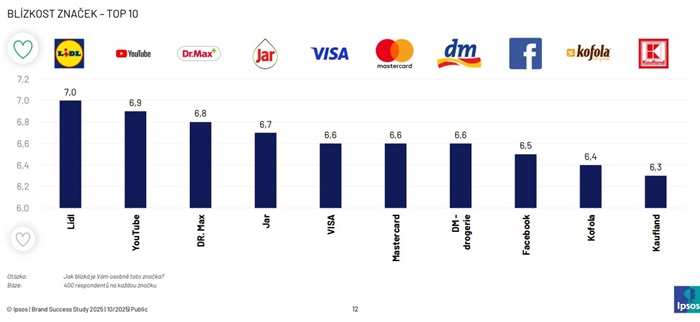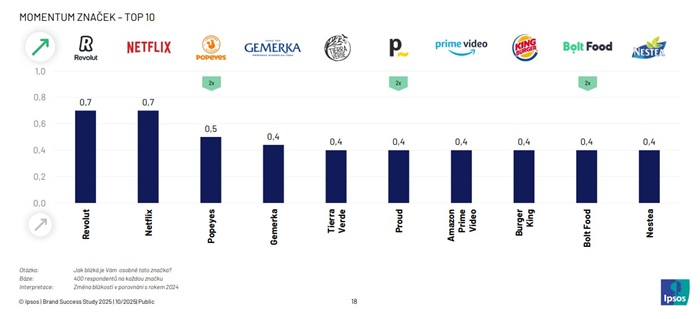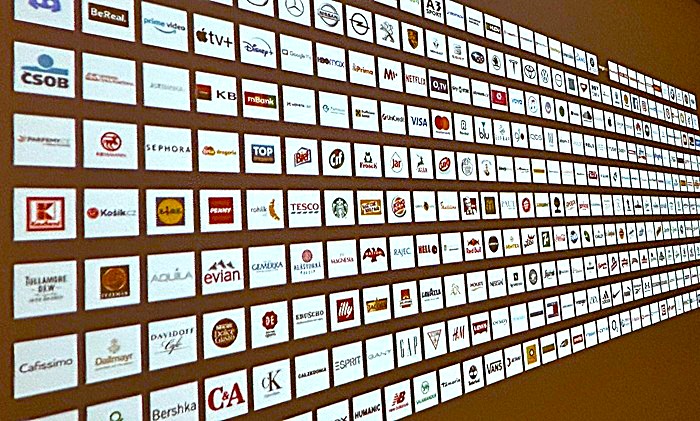Czech consumers identify Lidl as their closest brand, followed by YouTube and the Dr. Max pharmacy chain, which is also the highest ranked purely Czech brand. This is according to an updated survey by Ipsos.
Only 13% of the brands surveyed are close to Czechs, while 63% of them are known to Czechs overall. The top three brands remain unchanged compared to last year. The representation of the top 10 brands is also the same, with some of them only switching their rankings.
A total of 300 brands in 33 categories were included in the survey. Czechs have the most positive expectations towards supermarkets, pharmacies and credit cards, and newly also towards brands in the housing and DIY (hobby and DIY) sectors. According to Ipsos, these categories are close to consumers because they encounter them frequently and associate them with everyday life.
TOP 10 brands that Czechs consider close to
 Source: Ipsos | Brand Success Study 2025, Q: How close is this brand to you personally?, base: 400 respondents for each brand
Source: Ipsos | Brand Success Study 2025, Q: How close is this brand to you personally?, base: 400 respondents for each brand"Brand popularity among Czechs does not change much," said Michal Štěpánek from Ipsos. According to the survey, only six percent of brands have improved in the eyes of consumers year-on-year. The reasons for growth vary by category—for example, customer experience and online availability play a role in payment cards and courier services, while availability at points of sale plays a role in mineral water.
From a generational perspective, the youngest target group, which partially overlaps with Generation Z and Y, is closer to fast-paced lifestyle brands (social networks, fast food chains) than other generations.
The brands that best create positive expectations in their categories are Lidl, Visa, MasterCard, Dr.Max, Nike, Kofola, OBI, Ikea, Jar, T-Mobile, and Samsung.
Brands that best meet expectations in individual segments
- Supermarkets: Lidl, Kaufland, and Albert
- Pharmacies: Max, Benu, and Pilulka.cz
- Financial services and cards: Visa, Mastercard, and Air Bank
- Sports fashion, clothing, and footwear: Nike, Adidas, and Deichmann
- Mineral water, CSD, energy: Kofola, Magnesia, and Mattoni
- DIY: OBI, Hornbach, Baumax
- Housing: Ikea, Jysk, and Sconto,
- Household care: Jar, Savo, and Cif,
- Telecommunications: T-Mobile, O2, and Vodafone,
- Mobile phones: Samsung, Google, and Apple.
Interestingly, Samsung is ahead of Apple in Czechia, which researchers explain by the finding that Samsung is a stronger brand than Apple for Czechs.
The biggest year-on-year positive shift was recorded by the brands Revolut, Netflix, and Popeyes. In terms of growth, Popeyes, Proud, and Bolt Food are particularly interesting, having grown for two years in a row.
Change in proximity compared to 2024 – TOP 10
 Source: Ipsos | Brand Success Study 2025, Q: How close is this brand to you personally?, base: 400 respondents for each brand
Source: Ipsos | Brand Success Study 2025, Q: How close is this brand to you personally?, base: 400 respondents for each brandAccording to Ipsos, growing brands have several factors in common: they have a digital-first approach, simplify life and offer convenience, emphasize value overlap (e.g. sustainability or community), and are part of the lifestyle of younger generations.
Among the growing brands, according to Ipsos research, there are leaders that have managed to strengthen: Netflix, CSOB and especially Rossmann, which grew for the second year in a row. Gemerka or HeroHero and Tierra Verde are also growing among the challengers.
For smaller, lesser-known brands, the key to gaining proximity is all about increasing familiarity - until a brand becomes known to people, it's hard to get into the buying mix. Conversely, for established and leading brands, there is even more work to be done to create positive expectations.
According to Michal Stepanek, there are three key factors behind a long-lasting brand - expectations, context and empathy. "A brand must have a clearly established network of associations so that people know what it is about and what they can expect from it. It must also be able to respond to trends and stand out at different moments of consumption. Last but not least, it is important that people feel that the brand is listening to them," he summarises.
Source: mediaguru.cz

